“Oshkosh knew the recompete was coming and has built an IP portfolio that strategically overlaps with the Technical Data Package…[which], while handing over certain types of information, does not bar Oshkosh from asserting their utility patents, design patents and trademarks.”
Oshkosh Corporation has run through a $6.7 billion contract to produce the first 17,000 Joint Light Tactical Vehicles (JLTVs) in a Department of Defense (DOD) program that could produce 55,000 vehicles for the Army and Marines. Oshkosh won the low-rate initial production (LRIP) contract in 2015 to be the sole manufacturer of JLTVs by submitting an original, technologically superior design in a litigated competition with other, arguably, more dominant players in the defense market. Bids for the contract to produce the next tranche of over 15,000 vehicles are due later this year. Competitors for the $7.3 billion recompete contract, including GM Defense, AM General and Navistar, will have access to the proprietary design of the JLTV that Oshkosh used to win the LRIP contract. The U.S. Government has made available to interested bidders a Technical Data Package (TDP) covering the JLTV after purchasing an option in 2016. Oshkosh, however, maintains an intellectual property (IP) portfolio that could counter the sale of the TDP.
Oshkosh will be facing stiff headwinds in their bid to continue producing the heir to the Jeep and Highly Mobile Multi-Wheeled Vehicle (HMMWV). The recompete contract will reportedly be awarded to only one bidder. The A2 version of the JLTV will include new features, such as 360° camera viewing, that play into the strengths of competitors that manufacture commercial automobiles. Congress required the recompete to push costs down. All this while the Government is looking to promote a competitive and diverse defense industrial base.
But Oshkosh knew the recompete was coming and has built an IP portfolio that strategically overlaps with the TDP. Oshkosh advertises that they have over 80 patent assets directed to the JLTV, including their “patented TAK-4® suspension” and “iconic A-Frame emblem.” The TDP, while handing over certain types of information, does not bar Oshkosh from asserting their utility patents, design patents and trademarks.
IP Rights Excluded from Technical Data Package
As defined by DI-SES-8077B, a TDP “is the authoritative technical description of an item” that “supports the acquisition, production, inspection, engineering, and logistics of the item.” The TDP “consists of applicable technical data, such as: models, drawings, associated lists, engineering design data, specifications, standards, performance requirements, quality assurance provisions, software documentation, and packaging detail.”
“The purpose of the TDP is to provide a technical description of an item which is clear, complete and accurate and in a form and format adequate for its intended use. TDPs define the physical and functional characteristics of the accepted configuration of the item and its subordinate assemblies, subassemblies, and parts” per Mil-Standard 31000B.
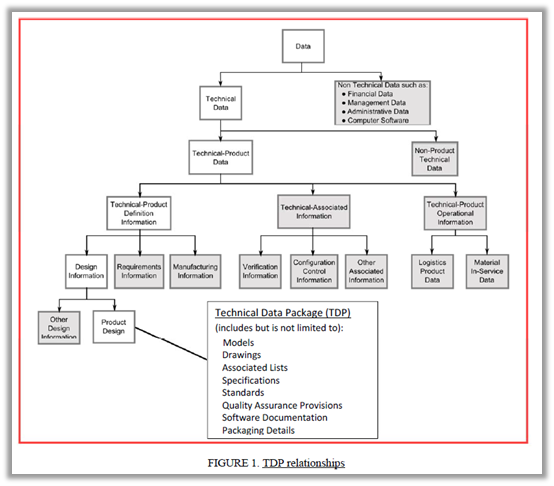
FIGURE 1 of Mil-Standard 31000B
Thus, the TDP includes information needed to manufacture the JLTV according to government specifications, but does not include rights to practice patented inventions required to meet those specifications. MIL-STD-3100B specifies that the “acquisition of commercial engineering design data almost always involves rights in data and intellectual property issues” and instructs that IP rights should be defined “in the contract in accordance with DFARS Parts 211 and 227” and that the TDP standard “will not be used to circumvent the DFARS requirements.” As such, it is entirely incumbent on the Government to negotiate rights to specific IP assets separate from the TDP.
Utility Patents Cloud the Recompete Process
Building the A2 version of the JLTV for the recompete contract might require practicing any of Oshkosh’s patented inventions. The obstacle provided by these patents could be traversed in a few different ways. The Government may have license to the patented technology through any of the earlier JLTV prototype and LRIP contracts with Oshkosh. Competitors may have to design around the patents or license directly from Oshkosh. Lastly, Oshkosh may find themselves suing the Government as a remedy for competitors building infringing JLTVs without license.
If the patents are directed to “subject inventions” of a government contract, the Government would have acquired licenses to practice the inventions. A subject invention is “any invention of the Contractor made in the performance of work under [the] contract.” Failure to comply with contract invention reporting requirements can result in forfeiture of the patent.
A review of Oshkosh’s patent portfolio did not reveal any government rights notices for the JLTV. For example, U.S. 11,273,804 titled “Military Vehicle” and U.S. 8,801,017 titled “Position Dependent Damper for a Vehicle Suspension System” have priority dates that possibly predate the JLTV contracts. Thus, it does not appear that the Government has any rights to subject inventions.
The Government has provided contractors some guidance regarding accessing patented technology of the JLTV. When asked generally about patents, according to a Q&A document maintained by the DOD throughout the recompete process, the Government indicated that they are “not currently aware of any sources which will not quote parts to interested offerors other than the incumbent. If the offeror encounters this scenario, the Government requests that the offeror provide that information and correspondence so the Government can research it further.”
The Government was a little more evasive when asked specifically about Oshkosh’s patents.
Q: Are there any Oshkosh patented parts in the JLTV (e.g., TAK-4), and if so how would a contractor source these parts (e.g., required to source through Oshkosh)?
A: Generally the Government publishes patents so this should be addressed by making use [of] publicly accessible information.
Thus, the Government appears to be requiring bidders to secure their own patent licenses from Oshkosh. It is unclear if Oshkosh would be willing to license any JLTV patents to competitors. As such, there remains the possibility that the Government will force Oshkosh into seeking compensation for competitors using patented JLTV technology.
If the Government selects a bid for the A2 that includes unlicensed patented technology from a competitor, Oshkosh’s sole recourse would be to sue the Government for the competitor’s infringement. 28 U.S. Code §?1498 imposes patent infringement liability on the Government for unlicensed use or manufacture by contractors that occurs “with the authorization or consent of the Government.” But, even if a competitor’s proposal comes in as technologically superior and less expensive than Oshkosh’s proposal, it seems unlikely the Government would consider willful infringement given their recent efforts to demonstrate respect for IP rights. Oshkosh will, however, likely take any opportunity to enforce their IP rights if they do not win the recompete contract, as they have done against private companies and the Government.
Brand Protection for Non-Technical Features
Regardless of the recompete outcome, Oshkosh will be able to maintain their brand identity as the originator of the JLTV, while distancing themselves from issues that might arise from a competitor’s version of the JLTV, using design patents and trademarks.
As can be seen in the images below, the design patents and trademarks match with features of the JLTV’s appearance.

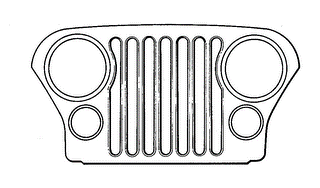
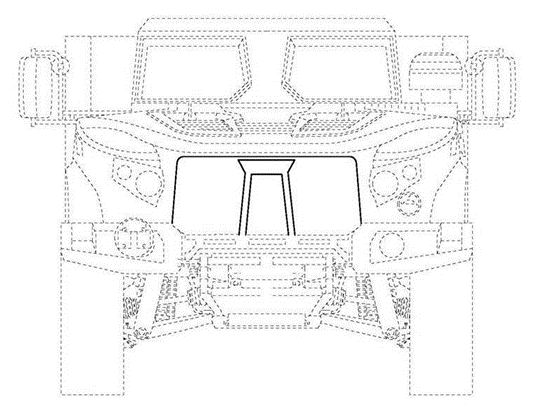
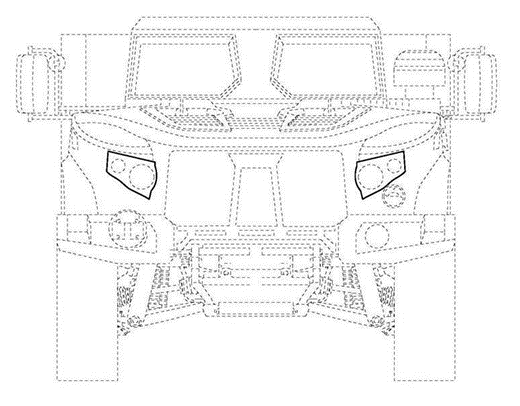
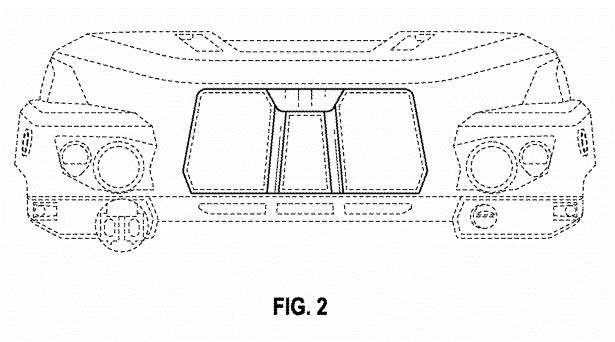
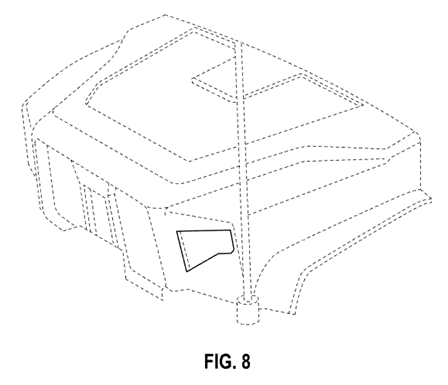
Design patents are directed to ornamental designs for articles of manufacture. Design patents are useful in protecting against knock-offs and secondary market products, or in this case a competitor making a re-compete product. Since 2017, Oshkosh has amassed 14 design patents relating to the ornamental design of the JLTV’s hood and grille.
The design patents are directed to the aforementioned “A-Frame emblem” and other aspects of the hood, such as the shape of the headlight cutouts.
Design patents can be invalid for being directed to a functional design where the use or purpose of the article dictates the design. Thus, valid design patents do not include “technical information” and are almost by definition excluded from TDPs per DI-SES-8077B.
Oshkosh’s design patents will force competitors to change ornamental aspects of their JLTV A2 submissions. Such changes would most likely be acceptable to the DOD if they can obtain a product that meets all of the TDP requirements and the hoods and grilles for the competitor’s designs are interchangeable with Oshkosh’s hoods and grilles.
Oshkosh recently filed eight trademark applications related to various portions of a vehicle. The first use in commerce of the marks is indicated as being in 2013, which is earlier than their JLTV contracts. Purely functional trademarks are not permitted, thereby providing the same separation from a TDP as design patents.
Though overlapping with the design patent portfolio, trademark protection lasts longer than design patent protection and public disclosure of a trademark is not fatal the way it can be for patents. Perhaps more importantly, trademarks indicate the source of a product, thereby protecting quality. Oshkosh has a strong reputation with the Government as is evident by their long history of producing other vehicles for the DOD, such as the HEMTT and MRAP. Oshkosh would surely want to protect their image with the public as being inheritors of the HMMWV (or “Hummer”) and Jeep legacy, particularly if they are interested in protecting non-military products.
Jeep and Hummer Set IP Precedent for Co-Manufacturers and Commercial Sales
Willys-Overland Motors won the initial contract to produce Jeeps at the onset of WWII, but the Government granted Ford a second-source contract to produce Jeeps as the global conflict escalated. Because the Government insisted on interchangeability between parts manufactured by Willys and Ford, Willys exchanged plans for the Jeep and licenses to any patents for guarantees to make Jeeps at their production capacity.
Willys eventually changed the grille for civilian models to the familiar 7-slot design to distinguish from Ford’s 9-slot stamped design, which itself was a manufacturing improvement over Willys’ original welded design.
The HMMWV is less instructive for the JLTV program because AM General is the only HMMWV manufacturer. Furthermore, historical joint ownership of the Jeep and Hummer brands has prevented Jeep and Hummer IP from being enforced against each other.
The Jeep and Hummer brands have both been successfully defended against other civilian manufacturers. General Motors sued Avanti in 2003 for diluting the Hummer brand, in a case that was eventually settled. Fiat Chrysler was also successful in protecting Jeep trade dress against Mahindra.
Oshkosh cannot sell the JLTV to the civilian market due to weight limitations. Oshkosh is also not a player in the civilian vehicle market. But, would-be JLTV producer GM Defense is owned by one of the largest automobile producers in the world and it wouldn’t be out of the question for GM to pursue a civilian JLTV as it did with the Hummer.
Oshkosh’s IP for brand protection will serve them in the defense and civilian vehicle markets, whether or not they win the recompete contract. But, Oshkosh need not actually be in any vehicle market to protect their JLTV brand with design patents and trademarks.
Non-Vehicle Markets Provide Additional Enforcement Opportunities
General Motors was able to prevent a toy manufacturer from using “Humvee” in association with selling toy models of the HMMWV under trademark and trade dress theories. In a case that was settled, BMW prevented an online retailer of “stock 3-D models” from selling digital models of various BMW vehicles after filing a complaint alleging various trademark and design patent claims. Toy models and digital models of the JLTV are currently being offered for sale.
Also, in an unsuccessful attempt at trademark enforcement, AM General failed to prevent Activision Blizzard from using HMMWV likenesses in a video game. For this,Oshkosh might need to seek their own design patent protection for “a graphical user interface showing an armored vehicle.”
IP Helps Oshkosh Stay Ahead of the Competition
Oshkosh’s track record in the wheeled vehicle market proves they have the technological and business expertise to retain the JLTV contract despite parting with the TDP. James Hasik has described Oshkosh as having the ability to provide the Government the product and pricing it desires, with or without the sale of a TDP, to the point of almost understanding “the Army’s thinking on procurement as well as the Army itself.” As for the JLTV, Oshkosh may have shown the ability to understand IP protection better than the Government. It’s no wonder Oshkosh remains confident they can win the recompete contract and, if not, at least force competitors to differentiate their JLTV designs.

![[IPWatchdog Logo]](https://ipwatchdog.com/wp-content/themes/IPWatchdog%20-%202023/assets/images/temp/logo-small@2x.png)

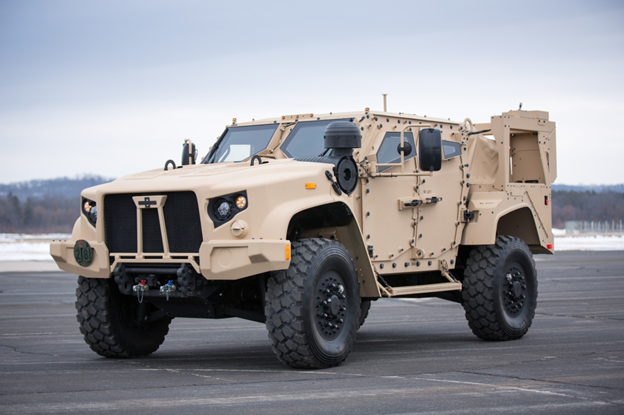
![[Advertisement]](https://ipwatchdog.com/wp-content/uploads/2024/04/Artificial-Intelligence-2024-REPLAY-sidebar-700x500-corrected.jpg)
![[Advertisement]](https://ipwatchdog.com/wp-content/uploads/2024/04/UnitedLex-May-2-2024-sidebar-700x500-1.jpg)
![[Advertisement]](https://ipwatchdog.com/wp-content/uploads/2024/04/Patent-Litigation-Masters-2024-sidebar-700x500-1.jpg)

![[Advertisement]](https://ipwatchdog.com/wp-content/uploads/2021/12/WEBINAR-336-x-280-px.png)
![[Advertisement]](https://ipwatchdog.com/wp-content/uploads/2021/12/2021-Patent-Practice-on-Demand-recorded-Feb-2021-336-x-280.jpg)
![[Advertisement]](https://ipwatchdog.com/wp-content/uploads/2021/12/Ad-4-The-Invent-Patent-System™.png)






Join the Discussion
No comments yet.